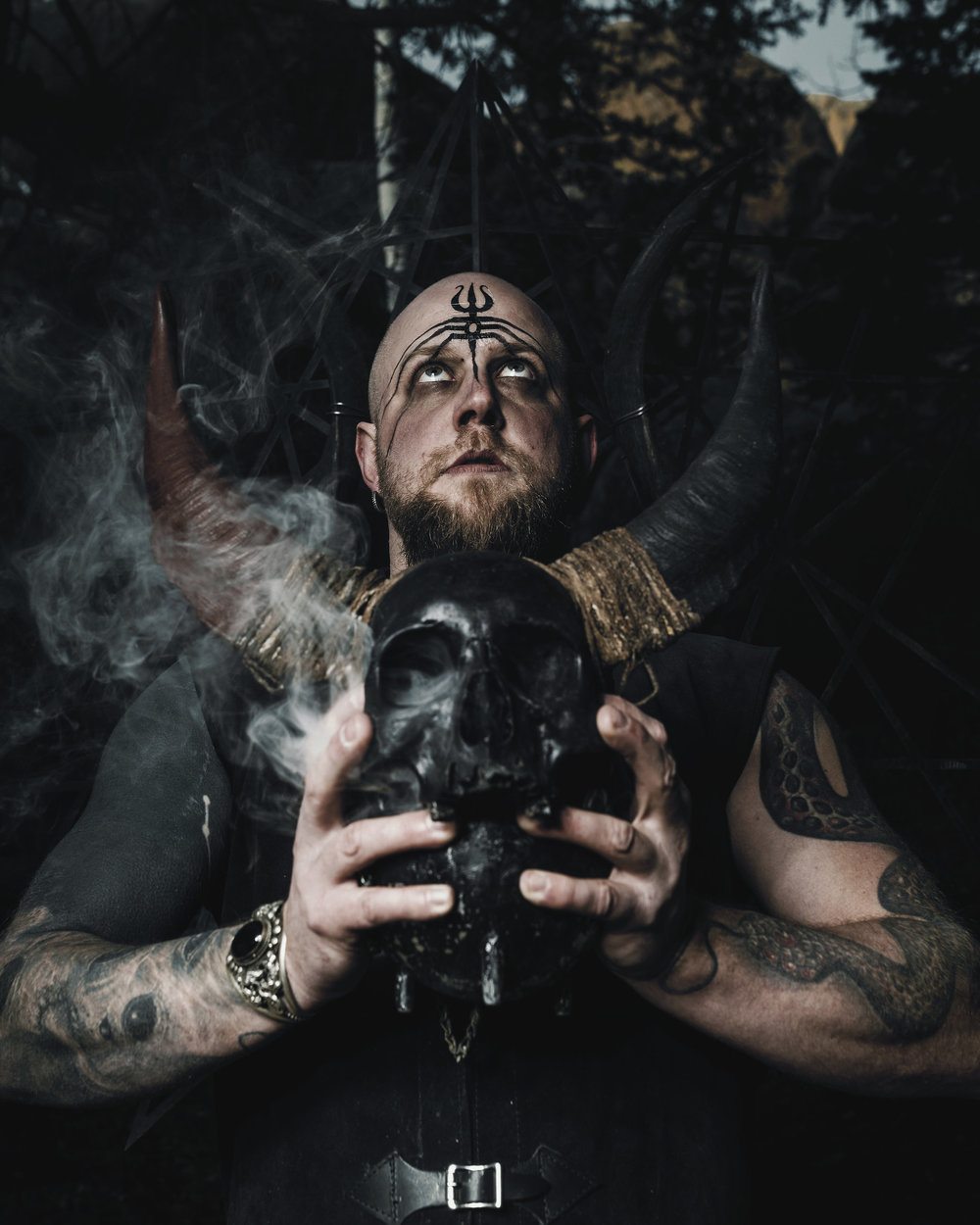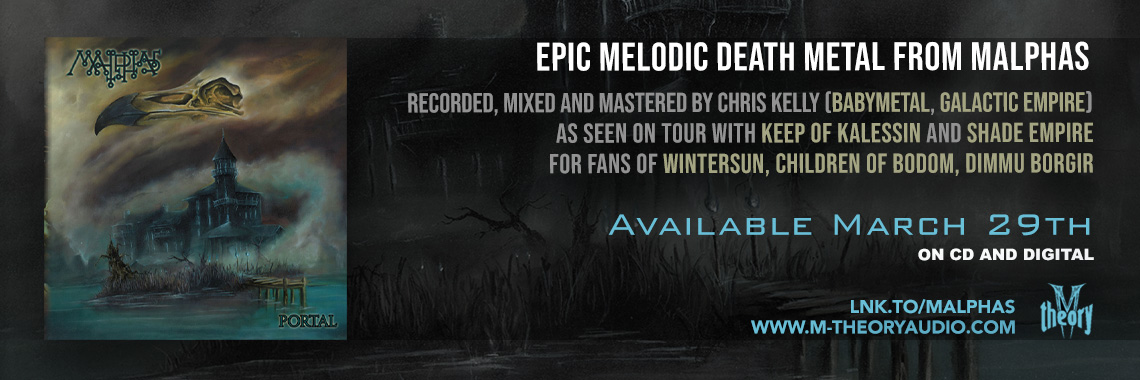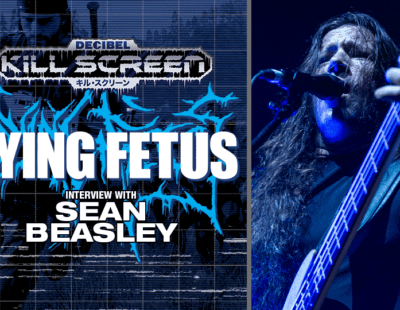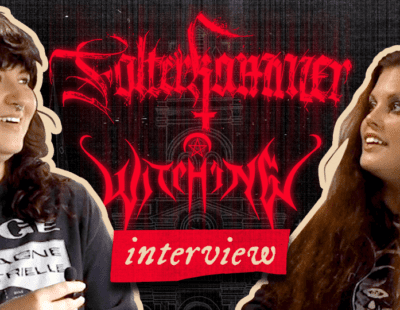
This interview comes from the May issue of Decibel. You can preorder Terra Damnata, out April 14 through Season of Mist, here. Interview by Forrest Pitts.

A correspondence with USBM pedagogues Nightbringer is a lot like delving into one of the band’s compositions. It’s gonna be imposing, it’s gonna be ornate and it’s bound be a trifle confounding, (though on the bright side, it’ll also likely contain fewer oaths and far, far less wrath.) While 2014’s Ego Dominus Tuus effectively established Nightbringer as a band that any black metal dilettante from either side of the pond should be sweating, the group’s current release Terra Damnata, (available now via Seasons of Mist,) sees them absolutely vaulting that benchmark by creating a work that’s both refined and arguably important enough to overstep the limitations of the black metal genre altogether, even as it studiously functions within its framework. Over the following conversation, guitarist/vocalists Ophis and Naas Alcameth along with lead vocalist Ar-Ra’ad al-Iblis casually drop the proverbial pearls before swine like a heart drops motherfucking beats. Ladies and gentlemen, we’re going to go deep here…
Is there an overarching theme to Terra Damnata? As I understood it, Ego Dominus Tuus revolved around the journey of an initiate into spiritual mystery.
Also, I know that poetry was integral to Ego…. You’ve previously cited Yeats, Donne and Baudelaire as points of inspiration. What written works helped to draw Terra Damnata into form?
Ophis: There is an overall theme relating to the album title, yes, though some tracks are more thematically linked than others. I don’t think there are specific poetic references this time, though we did quote Cicero in the lyrics. As far as other written works, we have found inspiration from the writings of Julius Evola, Andrew Chumbley, and MacGregor Mathers to name a few. The phrase Terra Damnata itself is yet another reference to alchemical negrido, though having other connotations related to the current state of mankind and the world today.
Naas Alcameth: The works of Peter Kingsley were also very influential, as well as Nigel Jakson’s earlier works regarding European witchcraft.

Speaking of poetry, (album cover artist,) David Herreria’s work distinctly recalls the paintings of William Blake, whose prose you’ve expressed admiration for. Do you recognize that similarity? How does Herreria’s piece for the current album relate to its contents in your opinion?
Ophis: We are lucky indeed to be able to work with an artist of David’s caliber. Like Blake, he creates art that is visionary and symbolic, even if it looks rather different to my eyes, though I can see what you are getting at. Specifically, I see the album art relating to the lyrical content of several tracks, especially “Midnight’s Crown” and “Misrule”, tracks having to do with the Great Dragon and the celestial pole, among other things.
Naas: Unlike previous albums this piece was not rendered for us specifically but we felt that it fit perfectly with themes central to the album, as Ophis has mentioned. A black sphere below, enshrined within the center of the skull, with axis pole leading up to the winged figures head which is ablaze with a shining white sphere… Black star below, white above. The white line bisecting the horizon. A black line rising from the black star and shooting off to the left. Such symbolism is particularly relevant to ceremonial magic and groups such as the Golden Dawn, AA, or certain recensions of witchcraft. The skull appears as a tunnel from which the daemonic face seems to arise from, forward facing just behind the place of the Ajna or eye of Shiva from which shines the starlight of Daath. The white garment looks to be falling away, which brings to mind certain eastern doctrines where the removal of clothing reveals the full and unrestrained power of a divine being. This could also be perceived as the winding cloth of burial being cast off. There is a lot that can be seen within this one piece and many relevant interpretations. It is interesting to note, as David shares similar influences, (to ours,) regarding the occult.
There are arresting points of harmonic dissension studding Damnata…, (the quarter-note sharp lead that absolutely tears at the synth backdrop in the chorus of “Misrule,” for example.) Additionally, the vocals have become more eccentric and varied, (the treatments for “Midnight’s Crown” leap to mind.) Would you at all ascribe Nightbringer’s current sense of creative liberty to your comfortability in working with (producer/engineer,) Dave Otero again? Were the recording sessions as satisfying to you as those of Ego Dominus purportedly were?
Ophis: Some of the vocal variety (as in the track you mentioned) has to do with the fact that I contributed far more to that this time around. I think that between Naas and myself our vocal styles definitely complement each other, something we were able to use to good effect. In terms of recording, everything was done roughly the same way as on the previous album, which is to say we arranged and recorded the guitars and vocals ourselves. Dave always brings great ideas to the table when we get to the mixing and mastering stage, and ultimately he is responsible for the overall sound of the album.
Naas: Ophis had contributed some vocal work in the past but nothing to this extent. I feel his style is very unique and quite powerful and compliments aR R’ad’s and my own very well. Between the three of us there is quite a bit of dynamic.

I’ve read allusions equating Nightbringer with more spartan outfits, particularly Dark Funeral, to which I wholeheartedly disagree. I feel that Terra Damnata most distinctly recalls Emperor, both at their most traditional as well as at their most far-sighted and baroque. “Inheritor of a Dying World” plays out like a series of movements corresponding to the Reverence EP before wandering into a passage (2:49-3:13) that recalls the brazen eccentricity of IX Equilibrium. Does Nightbringer recognize this affinity or is its appearance merely happenstance?
Ophis: Speaking for myself, Dark Funeral was never a direct inspiration; I only ever listened to their albums a handful of times. But you are right about Emperor. We have always held their earlier albums in high regard, so they have definitely been influential. However, when it comes to writing music, it’s probably more a matter of a similar approach ultimately derived from classical and soundtrack music. We try to maintain a balance though. We don’t care for the direction that Emperor ultimately took, so there are limits to how we approach writing music in this way.
Naas: As much as I can appreciate the first few albums by Dark Funeral they are not an act I have followed really. The early works of Emperor, however, were certainly influential, along with other acts such as Arcturus, whose classical influence was evident and quite ingenious.
Many of the mysteries that Nightbringer allude to appear rooted in Hermeticism. Is this a fair assessment? If not, would you care to distinguish for me the avenue of spirituality that Nightbringer currently pursues?
Ar-Ra’ad al-Iblis: I think it is safer to say that Nightbringer is rooted in what could loosely be defined as the western esoteric tradition as a whole. For various reasons however, the term hermeticism has now and then become synonymous with this tradition although that might to some degree lead to problems of specification, (I suppose.) For instance, we have time and again been highly drawn to neoplatonic philosophy in our work, which at least from a classic standpoint should be distinguished from hermeticism although they obviously share plenty of similar traces. These similar features can to some extent be found in a variety of religious and philosophical schools and sects throughout western history and although they have come to superficially change through the specific context they are brought into; the inner core always remain the same. They all speak of man’s true origin as a spiritual being which carries the spark of the divine source of all reality within itself and then in extension of how this spark can properly be revealed and cultivated.
Nightbringer’s religious perspective strikes me as relatively open and inclusive, especially when compared with the convictions associated with more orthodox black metal outfits. You appear willing to interlace “truths” from any worthy discipline, no matter how disparate. To hear the band reference the Qabalah was especially striking to me given the historical, (read: oftentimes anti-Semitic,) context of black metal. Has your philosophy always been this comprehensive?
Ophis: My spiritual perspective and inspirations have changed little since I first became involved with Nightbringer. I was always interested in diverse traditions- after all, there would have to be some level of universality to such things if there is truth to it, similar in a way to how modern science confirms a theory through repeatable experimentation. Speaking just of such a figure as the Adversary, one can find traces in diverse places, and in fact it would be odd if this were not the case. The Qabalah we have found to be of interest is really Hermetic Qabalah, if such a term be permitted, which has closer relations to Platonism than it does to Judaism. In general, I don’t see any reason to limit oneself when it comes to such things, though one must be fastidious and not become lost in a kind of syncretistic mish mash.
Naas: The gnosis these seemingly diverse beliefs and systems might reveal belongs to no one particular people or time. It is divine and like all things divine in origin, is received from the divine, not constructed by man. I believe that truth is indeed perennial and indivisible, it only gains apparent differentiation via the lens of culture and time from which it is perceived, and by how it is applied and approached. In regards to the master student relationship, this is central to the concept of initiation and without such a link the life blood of any “living tradition” ceases to flow. There is, however, the possibility of reception of such knowledge via spirits, dreams, what have you, and which has in one form of witchcraft been referred to as the “lonely path”. The concept of spontaneous gnosis or innate transcendence without the catalyst of reception or initiating intelligence is all but unheard of.
On this note, you radiate the attitude of perennial students of your own evolving convictions, which is refreshing but also serves to underscore your sincerity. Other outfits who claim comparable spiritual attitudes often appear to equate the idea of discipleship with weakness and subordination. This approach seems self-defeating and lacks respect for the profundity of the sort of mysteries Nightbringer alludes to, honoring the mere posture of “mastery” as opposed to valuing the journey itself and actual advancement along the path. Do you sometimes find yourself frustrated by these sort of shallow overtures associated with the scene or is Nightbringer too absorbed in its own evolution to be ruffled by such aesthetic frippery?
Ophis: I think that within Black Metal you can tell the ones who have a real connection to the transcendent- they always express a sense of awe and deference to that which is greater than the all-too-human. It is a rare thing to have true mastery of anything, even more so when it comes to spiritual things. It is no weakness to admit that the normal human ego is an impoverished thing; the greater can only have an elevating effect on the lesser, so it is not a matter of servility. However, as Prometheans, we think there is something within man that is potentially Divine, so we do not grovel. Grandiose claims should certainly be met with skepticism, but in general, I don’t care to question the integrity of someone else’s path, I’m more concerned with my own. It will always be the case that those with eyes to see will see.
The elaborate, assiduously balanced orchestration of your compositions is suggestive of a great amount of discipline, (specifically, focus and attention.) Focus and attention, as I understand are requisites for the attainment of a higher plane of spiritual knowledge and transcendence. Are these particular qualities that Nightbringer, as both an entity and a collective actively endeavor to hone?
Ophis: Absolutely. We always try to maintain a balance between what you could call a more rationally constructive approach with fierier and chaotic inspiration. A marriage of Apollo and Dionysius if you will. As much as bands talk about chaos, if their music was purely that it would be unlistenable.
Can you clarify the spoken word accompaniment to “The Lamp of Inverse Light”?
Naas: The spoken accompaniment was taken from an interview with Julius Evola, [who’s been described by linguistics professor Aaron Gillette as ‘one of the most fascist racists in Italian history’ and is favorably cited by both Steve Bannon as well as white nationalist figurehead Richard Spencer, F.P.] an individual who is of great importance to us all, and has to do with the Left Hand Path in its original and accurate context.
When juxtaposed with black metal’s distinctive melodic phrasings, I’ve always found the blast beat to have a pronounced meditative quality. Is this an appreciation that you can relate to?
Ophis: The repetitive and droning aspect could perhaps be related to certain techniques useful for expanding one’s consciousness. It’s more of an underlying thing though, a substratum on which the musical edifice is built. If it’s a meditation, then it’s a meditation of fury and mania.






